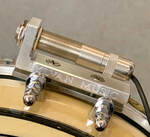|
Man, you know what really grinds my gears? Merriam Webster's definition for harmony: "the combination of different musical notes played or sung at the same time to produce a pleasing sound" First half we're doin' alright, different notes, same time. Yes, I am on board. However, I take issue with the concept of "pleasure" being included in this definition. I very specifically enjoy harmony others (of perhaps less refined palettes) might find displeasing. Maybe it makes them cringe in their seat a little, maybe there isn't that safe cadential figure leading back to "one." Guess what friends, there is no "one." Western music theory and harmony, and everything we listen to in this tradition, while a very neat and impressive collection of rules and ideas concerning organization of sound, is totally arbitrary. One may contend that the overtones in the harmonic series (those perfect 5ths and 3rds) are why we hear certain combinations of notes and sounds and we be like, "oh hey that sounds nice, what sweet pleasing sound." But naw dawg! The early Christian church (from which pretty much all contemporary music theory is derived) just had to control everything and codify things into rules, because God loves rules. So that really "dissonant" harmony, the one where there's two notes separated by six semitones, we're gonna call that "diabolus in musica," and you are NOT allowed to play it because it is so ugly and gross. Well, fortunately musicians quickly determined that the church was a goofball, and the "tension" present in this harmony (commonly referred to as the tritone) was resolvable, and as such could reflect the ebb and flow of life, like an exhale after holding your breath for too long, it could become something expressive. And it's true, to the Western ear, hearing an F against a B resolve into a C and E, sounds pretty satisfying, but also... saccharine. Why does that tritone have to resolve? Why can't it just hang out there and sound nice, be fine on its own, I think it sounds nice. Here are some of my favorite pieces of music that dare to subvert these Western traditions, as well as some resources if you're curious about some of the subjects mentioned: http://en.wikipedia.org/wiki/Overtone http://en.wikipedia.org/wiki/Tritone http://en.wikipedia.org/wiki/Atonality Schoenberg was a German composer from the Late Romantic period and began composing in that tradition before switching gears entirely, and inventing his own serialized approach to harmony organization. This piece predates his more organized 12-tone serialism, but it does a pretty beautiful job of ignoring a tonal center while remaining particularly Romantic in its expressivity and dynamics. Portal is a death metal band hailing from Australia. While this piece of music has trace elements of tonality, particularly around a minute and a half in, there is a very purveying sense of dissonance and atonality. The deliberateness in which they do not pander to Western tonality I find both hauntingly beautiful and terrifying. Also the video. Honestly I should've put this first. Ornette Coleman, and all pioneering Jazz musicians, were immediately pushing harmonic boundaries (all boundaries for that matter). This is an example of "free jazz," a musical movement with which Coleman was strongly associated. I will not begin to try to explain "free jazz" beyond mentioning that it is rooted far more in independent improvisatory melodic lines, but the resulting harmonies as we can hear in this piece are supreme. That poor lonely woman tho :(
0 Comments
Leave a Reply. |


 RSS Feed
RSS Feed



